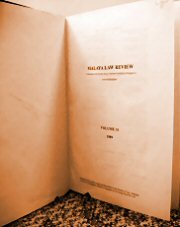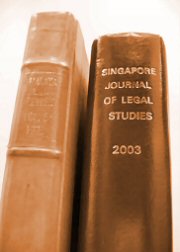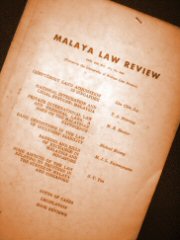|
Archive |
2396 records match your query:
| 281. | DECEMBER 2013 Issue | p.253 | |
| | The Case for a Legislative Amendment Against ‘Accessory Copyright' for Grey Market Products: What Can the U.S. Learn from Singapore and Australia?
Irene Calboli and Mary LaFrance • [2013] Sing JLS 253 (Dec)In this article, we suggest that the U.S. Congress could implement a legislative provision prohibiting copyright protection for incidental product features in the context of parallel imports. The U.S.would not be the first country to implement such a provision. In 1994, Singapore pioneered the adoption of a similar provision, which was introduced as an amendment to the SG 1987 Copyright Act. A few years later, in 1998, Australia incorporated a similar amendment to its Aust. Copyright Act 1968. In this article, we analyse in detail the Singapore and Australia provisions and, building upon these provisions, we suggest a specific amendment that the U.S. Congress could introduce into the U.S.Copyright Act of 1976.
| | 282. | DECEMBER 2013 Issue | p.278 | |
| | The Public Interest in Judicial Management
Tracey Evans Chan • [2013] Sing JLS 278 (Dec)The public interest is a common, but rarely discussed, feature in insolvency processes. It features in both winding up and judicial management in Singapore, with statutory provisions that stipulate the public interest as a ground for invoking these processes. However, it is unclear from the legislative deliberations what specific purpose was envisaged by the public interest exception to the typical requirements for making a judicial management order. This article reviews the concept of the public interest in the context of insolvency law in general, and corporate rescue in particular. In the light of the objectives and principles of insolvency law, and the role of the public interest, it argues for a revised, more robust understanding of the public interest in judicial management and its interaction with receivership.
[Full Text]
| | 283. | DECEMBER 2013 Issue | p.301 | |
| | The New Contractual Interpretation in Singapore: From Zurich Insurance to Sembcorp Marine
Goh Yihan • [2013] Sing JLS 301 (Dec)This article seeks in three ways to contribute to the continued refinement of contractual interpretation in Singapore following Zurich Insurance and, more recently, Sembcorp Marine. First, it identifies the key rulings of lawderived from the cases. From these will be distilled the relevant issues in contractual interpretation. In the particular context of Singapore,contractual interpretation encompasses related issues such as the admissibility of extrinsic evidence to interpret contracts and the substantive method used to interpret contracts. It is important to identify and distinguish between the exact issues because their conflation will lead to confusion in an area already affected by much complexity due to the concurrent application of statutory and common law principles. Second, this article evaluates the courts' approaches to those issues. The principal difficulty, as will be seen, is that there is a need to distinguish between statutory and common law principles. This is affected by the perceived need of adhering to the modern commercial reality of contextual interpretation, while balancing that with binding statutory materials. Third, this article suggests some possible reforms in the future. It considers whether it is possible to achieve a commercially sensible approach while keeping within the statutory constraints that bind the courts, or whether legislative reform is required.
| | 284. | DECEMBER 2013 Issue | p.331 | |
| | Unjust Enrichment and Restitution in Singapore: Where Now and Where Next?
Rachel Leow and Timothy Liau • [2013] Sing JLS 331 (Dec)The law of unjust enrichment and restitution is rife with academic debate, and the intense controversy surrounding it poses much headache for the uninitiated. Furthermore, the current shape and continued development of the law of unjust enrichment is the product of an ongoing conversation between academic commentators and courts, adding to the complexity of the field. In the first part of this paper, we aim to induct newcomers to the field by setting out four of the main academic debates. We then assess the present position of Singapore law on these debates. In the second part, we evaluate the Court of Appeal's recent description of unjust enrichment as a common law strict liability cause of action which is claimant-sided and focuses on the claimant's loss in AnnaWee. We argue that this description is too blunt, and that these broad generalisations should not be interpreted as drawing any definitive conceptual boundaries that might unduly hamstring the future development of the law of unjust enrichment.
[Full Text]
| | 285. | DECEMBER 2013 Issue | p.361 | |
| | Equitable Accessorial and Recipient Liability in Singapore
Pauline Ridge • [2013] Sing JLS 361 (Dec)This article considers three possible directions for the development of equitable accessorial and recipient liability in Singapore. These are suggested by leading cases in Singapore, Hong Kong and Australia concerning recipient liability. The first direction is closest to the status quo. It involves a contextual inquiry into dishonesty or unconscionability and exceptionally allows constructive notice to suffice for recipient liability. The second possibility is to treat the two forms of liability as involving the same participatory liability for breach of trust or fiduciary duty. The third possible direction is to maintain a distinction between the two forms of liability and to minimise the operation of recipient liability where there is a concurrent common lawclaim. The final part of the article considers whether it is possible to achieve autochthony in this area of law, given the various non-legal considerations that may influence the direction taken.
| | 286. | DECEMBER 2013 Issue | p.384 | |
| | The Achilleas: Struggling to Stay Afloat
Senthil Sabapathy • [2013] Sing JLS 384 (Dec)Remoteness in contract is an area which has faced much scrutiny across the common law world following The Achilleas. This article explores two contrasting approaches to the doctrine: a knowledge-based model premised on fairness, or respect for the defendant as an autonomous agent, and an agreement-centred approach based on the parties' implicit, rather than express intention. The status of the agreement-centred model in two jurisdictions—England and Singapore—shall then be explored. It shall be shown that the model has received a lukewarm, if not overtly hostile, reception which reflects its substantial theoretical and practical flaws.
| | 287. | DECEMBER 2013 Issue | p.402 | |
| | Copyright Subsistence in Contemporary Times: A Dead Shark, an Unmade Bed and Bright Lights in an Empty Room
David Tan and Chan Yong Neng • [2013] Sing JLS 402 (Dec)Singapore has seen a proliferation of contemporary art exhibitions and auctions in recent years. Installation art, like the infamous shark suspended in a tank of formaldehyde, can be worth millions of dollars in the world of contemporary art. This article examines whether installation artworks can satisfy the requirements for the subsistence of copyright in Singapore. The intrinsic characteristics of installation art, including the transient nature of particular works and its frequent use of ready made and natural objects, seem to be in conflict with the statutory definition of an 'artistic work' and with the copyright subsistence requirements of fixation and originality. The authors argue that there should not be a per se rule either against the recognition of installation works as sculptures—a specific category of artistic works—or more generally as artistic works. It will examine three of the most famous—and controversial—Turner Prize-nominated and winning works as illustrative case studies. The article also suggests that 'artistic purpose' is likely to have a more prominent role in the evaluative criteria used by courts for the classification of 'artistic works', particularly in the courts' approach to non-propositional installation works.
| | 288. | DECEMBER 2013 Issue | p.428 | |
| | The System of Private Caveats in Malaysia and Singapore: Some Reflections
Teo Keang Sood • [2013] Sing JLS 428 (Dec)This article undertakes a comparative study of the Malaysian and Singaporean systems of private caveats on the following three areas: the priority of unregistered interests, the entry of further caveats and the requirements to sustain a caveat. It seeks to determine the jurisdiction which best facilitates the policy objectives of the Torrens system of land registration in the three areas discussed.
| | 289. | DECEMBER 2013 Issue | p.447 | |
| | Legislation and Case Notes: Punishment and Protection - The Disqualification of Directors in Singapore
Pearlie Koh • [2013] Sing JLS 447 (Dec)The ability to operate behind the shield of the corporate form, thereby benefitting from limited liability, is thought to be a privilege conferred by statute. This privilege is however, curtailed for certain individuals who are “proven misfits”. The removal, by disqualification, of these individuals from corporate management is intended to protect the shareholders and creditors of the companies concerned from the possibility of future instances of undesirable conduct by these same individuals. Thus, the Companies Act of Singapore provides for disqualification from holding directorships or from management of a company on a number of grounds. Disqualification may be automatic or dependent on a court making a disqualification order.There is also recognition that disqualification is punitive. Indeed, the effect of a disqualification, given its “substantial interference with the freedom of the individual”, is at least quasi-penal.
| | 290. | DECEMBER 2013 Issue | p.457 | |
| | Legislation and Case Notes: Occupiers' Liability After See Toh: Change, Uncertainty and Complexity
Low Kee Yang • [2013] Sing JLS 457 (Dec)With the recent Court of Appeal decision in See Toh (C.A.), the Singapore law on occupiers' liability has undergone a sea change. There are two obvious changes.The first is that there is no longer a distinction between invitees and licensees; the law accords them the same protection. The second is that occupiers' liability is no longer a separate tort; it is now subsumed under the tort of negligence. However, the full implications of See Toh (C.A.) are more far-reaching and profound than a casual reading of this landmark decision might suggest.
| |
|
|


 |







